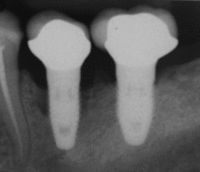Peri-implantitis

Peri-implantitis is the destructive inflammatory process affecting the soft and hard tissues surrounding dental implants.[1] The array of periodontal pathogens found around failing implants (those affected by peri-implantitis) are very similar to those found in association with various forms of periodontal disease.[2] In compound implants (two stage implants), between the actual implant and the superstructure (abutment) are gaps and cavities into which bacteria can penetrate from the oral cavity. Later these bacteria can return into the adjacent tissue and can cause peri-implantitis.
Treatment
Treatment may include removing dead tissue, antibiotics, and improved dental hygiene.[3] This may include the use of mouthwashes[4] and washing with chlorhexidine.[5]
References
- ↑ Mombelli, A. "Microbiology and antimicrobial therapy of peri-implantitis," Periodontology 2000 2002;28:177–189.
- ↑ Listgarten and Lai (2000), AAP In-Service Exam, 2008-B12
- ↑ Hsu, A; Kim, JW (2014). "How to manage a patient with peri-implantitis.". Journal (Canadian Dental Association). 79: e24. PMID 24598326.
- ↑ Pedrazzi, V; Escobar, EC; Cortelli, JR; Haas, AN; Andrade, AK; Pannuti, CM; Almeida, ER; Costa, FO; Cortelli, SC; Rode Sde, M (2014). "Antimicrobial mouthrinse use as an adjunct method in peri-implant biofilm control.". Brazilian oral research. 28 Spec. PMID 25003787.
- ↑ Renvert, S; Roos-Jansåker, AM; Claffey, N (September 2008). "Non-surgical treatment of peri-implant mucositis and peri-implantitis: a literature review.". Journal of clinical periodontology. 35 (8 Suppl): 305–15. doi:10.1111/j.1600-051x.2008.01276.x. PMID 18724858.